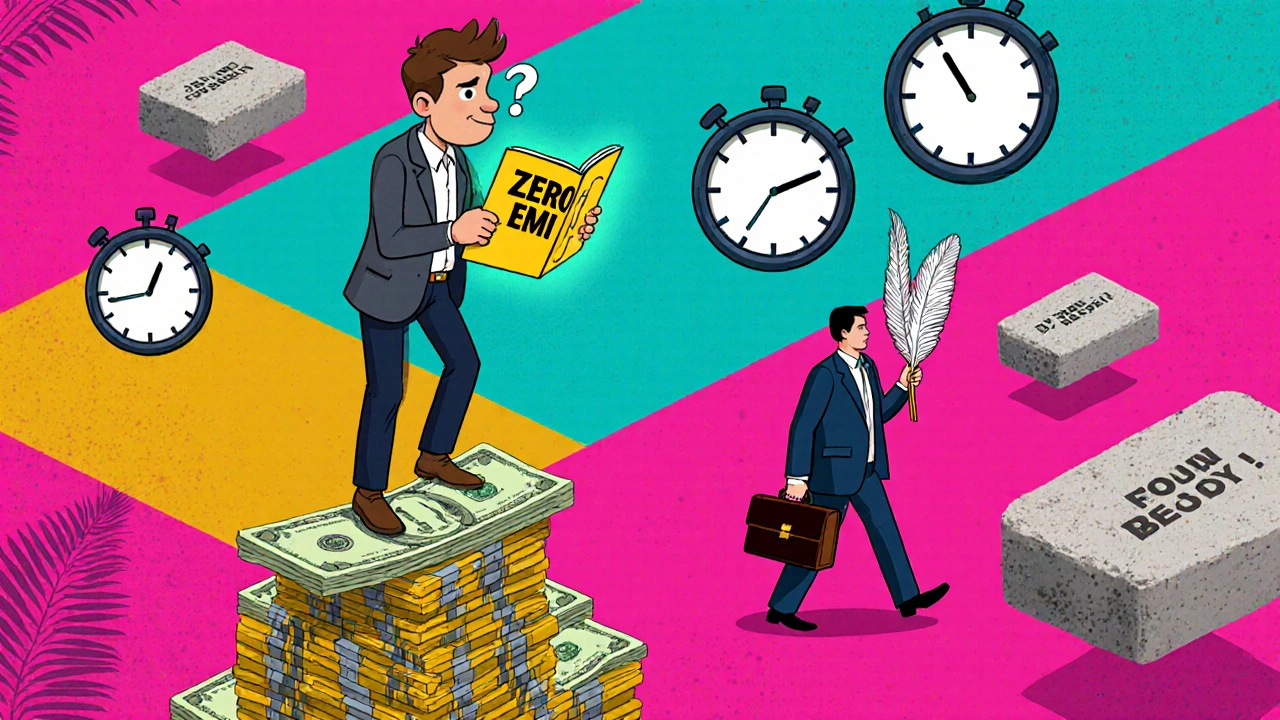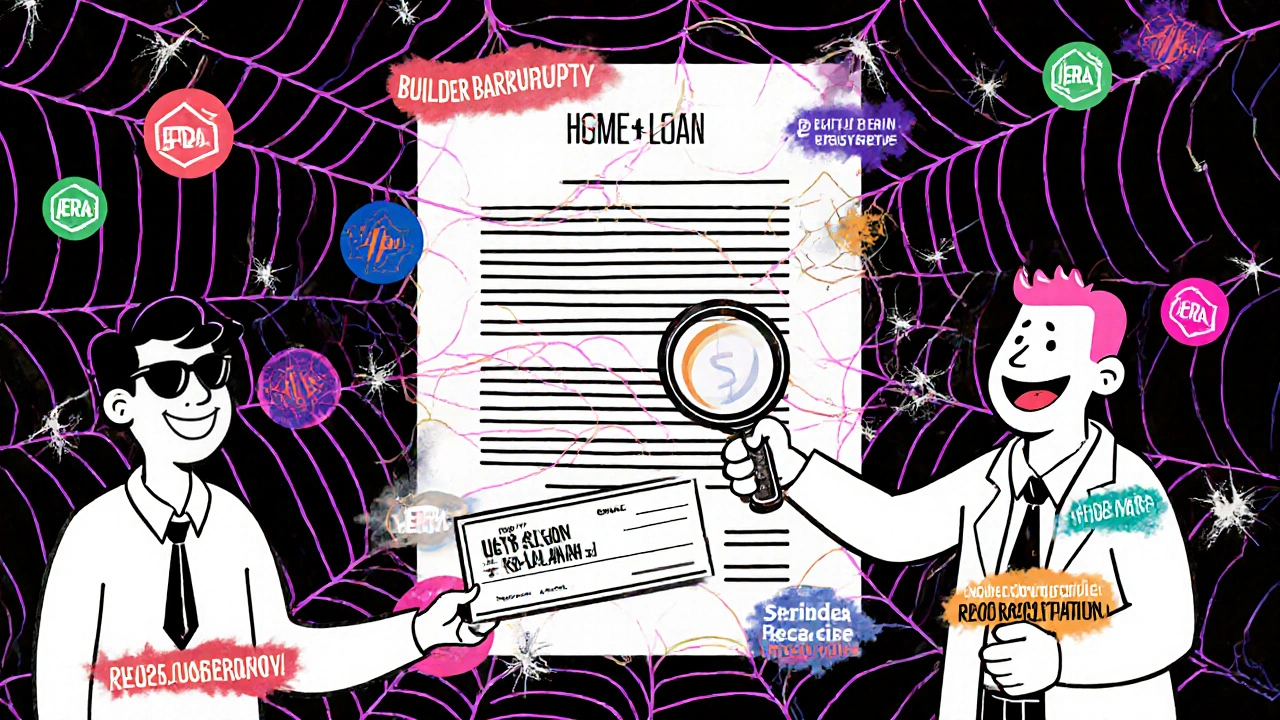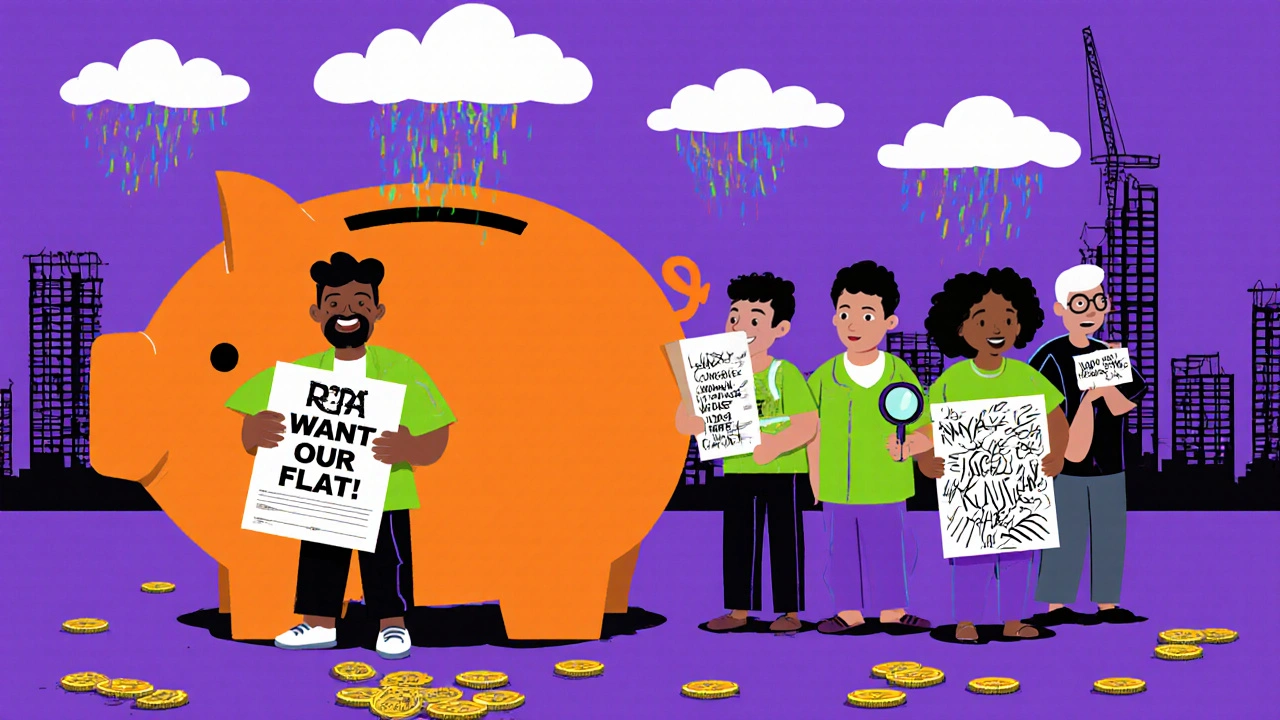Subvention Schemes in India: How Builder Payment Plans Work and What Risks You Face
 Nov, 21 2025
Nov, 21 2025
When you hear subvention schemes in India, you might think it’s a smart way to buy a home with zero EMI for months. But behind the shiny brochures and zero-interest promises lie hidden costs, delayed projects, and financial traps that have left thousands of buyers stuck. This isn’t theory-it’s what happened to Priya in Pune, who signed up for a subvention plan in 2022, paid 30% upfront, and is still waiting for her flat to be handed over in late 2025. Her bank loan was approved, but the builder never completed the construction. She’s paying interest on a loan for a house she can’t live in.
What Exactly Is a Subvention Scheme?
A subvention scheme is a payment plan where the builder pays the interest on your home loan until possession. You pay only the down payment upfront-usually 10% to 30%-and nothing else until the builder gives you the keys. The bank approves your loan, but you don’t start paying EMIs until the property is ready. Sounds perfect, right?
Here’s how it actually works: You sign a booking agreement. You pay your down payment. You apply for a home loan. The bank releases the loan amount to the builder in stages as construction progresses. But here’s the catch-the builder uses that money to fund the next phase of construction. Meanwhile, the builder pays the interest on your loan to the bank. You pay nothing until possession.
This model became popular in India between 2015 and 2020, especially in cities like Bangalore, Hyderabad, and Noida. Builders used it to attract buyers without needing to offer deep discounts. For buyers, it looked like free money. For banks, it meant more loans. For builders? It was a way to lock in cash upfront without the pressure of immediate delivery.
Why Builders Love Subvention Schemes
Builders don’t offer subvention schemes because they’re generous. They do it because it’s a cash flow hack.
Let’s say a flat costs ₹50 lakhs. Under a normal payment plan, you’d pay 20% upfront (₹10 lakhs), then 30% during construction, and the rest at possession. But under subvention, you pay only 15% upfront (₹7.5 lakhs), and the bank gives the builder the full loan amount-₹42.5 lakhs-right away. That’s ₹35 lakhs extra cash in the builder’s hands before they’ve even finished the foundation.
That cash lets them start the next project without waiting for sales. But if the project stalls-due to land disputes, funding gaps, or regulatory delays-the builder still has your loan money. You? You’re stuck paying interest on a loan for a house that doesn’t exist.
The Hidden Risks You’re Not Being Told
There are five big risks in subvention schemes that most agents won’t mention until it’s too late.
- Project delays are the norm, not the exception. In 2023, RERA data showed that 68% of projects in Tier-1 cities were delayed by over 12 months. Subvention schemes often promise possession in 24-30 months. Realistically, most take 36-48 months.
- You’re still liable for the loan. Even if the builder stops paying interest, your loan doesn’t vanish. The bank will start charging you EMIs-and they won’t wait for your flat to be ready. Many buyers get hit with retroactive interest for months or even years.
- Builders can walk away. If the builder goes bankrupt or gets blacklisted by RERA, your loan stays active. Your down payment? Gone. Your flat? Still a pile of concrete.
- Interest rates can change. Your subvention plan locks in the builder’s interest payment, but not yours. If the bank hikes rates during the delay, you’ll pay the difference once EMIs start.
- Documentation gaps. Many buyers don’t check if the project has all clearances. No RERA registration? No occupancy certificate? No bank loan disbursement. But if the builder says, “Don’t worry, we’ve got it covered,” that’s a red flag.
In 2024, a case in Gurgaon involved over 400 buyers who had paid for flats under subvention. The builder disappeared. The bank sued them for unpaid EMIs. The buyers had to pay ₹1.2 lakhs each in back interest-on homes they never received.

How to Spot a Safe Subvention Plan
Not all subvention schemes are traps. Some reputable builders still use them responsibly. Here’s how to tell the difference.
- Check RERA registration. Go to the official RERA website for your state. Search by project name. If it’s not listed, walk away. RERA registration means the project is legally tracked and the builder must follow timelines.
- Verify land title. Ask for the original land deed. Is it freehold? Is there a mortgage? If the land is pledged to another bank, your money could vanish if the builder defaults.
- Ask for a bank guarantee. A good builder will provide a bank guarantee that covers your down payment and interest if the project fails. This is rare-but when you see it, it’s a strong signal.
- Review the builder’s track record. Look at their past projects. How many were delivered on time? Are there RERA complaints? Check the RERA portal for pending cases. If they’ve had more than two complaints in the last three years, avoid them.
- Get a legal opinion. Pay ₹5,000-₹10,000 for a lawyer to review the agreement. Most buyers skip this. Don’t. The fine print often says the builder can delay without penalty if there’s a “force majeure.” That includes everything from monsoons to government orders.
Alternatives to Subvention Schemes
If you’re worried about the risks, there are safer ways to buy property in India.
- Ready-to-move-in properties. These cost more upfront, but you avoid all construction risk. You can inspect the unit, check the wiring, test the water pressure, and move in the same day.
- Pre-launch discounts without subvention. Some builders offer 10-15% discounts if you pay 50% upfront. You still pay EMIs from day one, but you’re not relying on a builder’s promise to pay your interest.
- Buy from government housing schemes. Pradhan Mantri Awas Yojana (PMAY) offers subsidies for middle-income buyers. Interest subsidies of up to ₹2.67 lakhs are available if you meet income criteria. No builder middleman. No subvention risk.
- Co-living or rental-to-own models. In cities like Pune and Ahmedabad, some developers now offer rental-to-own plans. You pay rent for 3-5 years, and part of it goes toward purchase. No loan risk until you decide to buy.

What to Do If You’re Already Trapped
If you’ve already paid under a subvention plan and the builder is delayed, don’t wait. Act now.
- File a complaint with RERA. Every state has an online portal. Upload your agreement, payment receipts, and correspondence. RERA is required to respond within 60 days.
- Request a refund with interest. Under RERA Section 18, if the builder delays beyond the promised date, you’re entitled to a full refund plus 10% annual interest.
- Don’t stop loan payments unless you have legal advice. Stopping EMIs can hurt your credit score. Instead, ask your bank for a moratorium or restructuring. Many banks will work with you if you show proof of builder delay.
- Join a buyer’s group. If 10+ people are affected, form a collective. Legal action is cheaper and more effective when done together.
In 2024, a group of 87 buyers in Navi Mumbai filed a joint RERA complaint. Within four months, the builder returned 100% of their payments with 12% interest. They didn’t need a lawyer. Just a shared WhatsApp group and persistence.
The Bottom Line
Subvention schemes in India aren’t evil. But they’re risky. They work only if the builder is honest, financially stable, and legally compliant-and most aren’t. The allure of zero EMIs is powerful. But the cost of getting it wrong? Years of debt, ruined credit, and a home you’ll never own.
If you’re thinking of buying under a subvention plan, ask yourself: Would I still buy this if I had to pay EMIs from day one? If the answer is no, then you’re not buying a home-you’re betting on a builder’s ability to deliver.
Real estate is the biggest investment most people make. Don’t let a clever payment plan turn it into a financial trap.
Are subvention schemes legal in India?
Yes, subvention schemes are legal-but only if the builder is registered under RERA and follows all terms. Many builders misuse the structure to delay projects and misappropriate funds. If the builder fails to deliver, you’re still legally responsible for your home loan, even if the flat isn’t ready.
Can I exit a subvention plan after signing?
It’s extremely difficult. Most agreements have a non-refundable booking amount clause. You can try negotiating a refund, but builders rarely agree unless pressured by RERA or a group of buyers. Always get legal advice before signing.
What happens if the builder goes bankrupt?
Your loan remains active. The bank will still demand EMIs. Your down payment is usually lost unless the builder provided a bank guarantee. In rare cases, the project may be taken over by another builder under RERA supervision, but this can take years.
Do all banks offer subvention-linked home loans?
No. Only certain banks partner with builders for subvention plans, usually large private lenders like HDFC, ICICI, or Axis. Public sector banks rarely participate. Always confirm with your bank before signing anything with the builder.
Is it better to pay more upfront and avoid subvention?
Yes, if you can afford it. Paying a higher down payment and starting EMIs early reduces your exposure to builder risk. You’ll pay more in interest upfront, but you’ll own your home faster and avoid the nightmare of delayed possession and retroactive interest charges.
